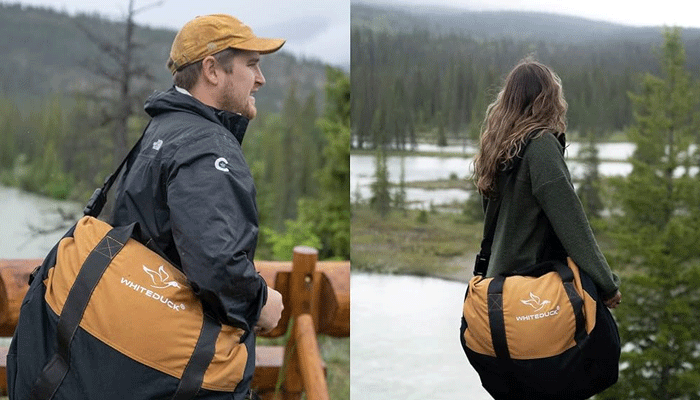
Camping is a wonderful way to explore the outdoors, connect with nature, and have fun with your friends or family. But to make the most of your camping experience, you need to have the right gear. And one of the most important items you need to pack is a camping bag.
A camping bag is a type of backpack that is designed to carry all your essentials for a camping trip, such as clothing, food, water, a sleeping bag, a tent, and other accessories. Depending on the length and style of your trip, you may need a different kind of camping bag to suit your needs.
But how do you choose the best camping bag for your needs? There are so many options available in the market, with different features, sizes, shapes, and prices. How do you know which one is right for you?
In this blog post, we will help you answer that question by providing you with some tips and guidelines on how to find the best camping bag for your needs. We will also review some of the best camping bags in 2024, based on our research and customer feedback. By the end of this post, you will have a better idea of what to look for in a camping bag and how to pick the best one for your next adventure.
What to Look for in a Camping Bag
Before you start browsing for camping bags, you need to consider some factors that will influence your decision. These factors include:
• The type of camping trip you are planning
• The duration of your camping trip
• The terrain and climate where you plan to camp
• The amount of gear you need to carry
• Your personal preferences and comfort
Let’s take a closer look at each of these elements.
The Type of Camping Trip You Are Planning
The first thing you need to think about is what kind of camping trip you are planning. There are different types of camping trips, such as:
• Car camping: This is when you drive to a campground and set up your tent near your car. You don’t have to carry your gear very far, so you can afford to bring more items and a larger bag.
• Backpacking: This is when you hike to a remote location and camp there. You have to carry your gear on your back, so you need to pack light and choose a smaller and lighter bag.
• Cabin camping: This is when you stay in a cabin or a lodge instead of a tent. You may still need to carry your gear to the cabin, but you don’t need to bring a tent or a sleeping bag. You can opt for a medium-sized bag that can fit your clothing and personal items. Enjoy the comfort of cabin camping and save on outdoor gear with the White Duck Outdoors Discount.
The Duration of Your Camping Trip
The next thing you need to consider is how long your camping trip will be. The longer your trip, the more gear you will need to bring, and the larger your bag should be. Here are some general guidelines on how to choose the right size of camping bag based on the duration of your trip:
• Day trip: If you are only going for a day trip, you don’t need a lot of gear. You can use a small daypack that can fit your water, snacks, first aid kit, and other essentials. A daypack usually has a capacity of 10 to 30 liters.
• Weekend trip: If you are going for a weekend trip, you will need more gear, such as a sleeping bag, a tent, a stove, and some clothing. You can use a medium-sized backpack that can fit your gear and still be comfortable to carry. A backpack usually has a capacity of 30 to 50 liters.
• Week-long trip: If you are going for a week-long trip, you will need even more gear, such as extra clothing, food, water, and accessories. You can use a large backpack that can fit all your gear and still have some room for extra items. A large backpack usually has a capacity of 50 to 80 liters.
The Weather and Terrain of Your Camping Destination
Another factor you need to consider is the weather and terrain of your camping destination. The weather and terrain will affect the type and amount of gear you need to bring, and the durability and weight of your bag. Here are some tips on how to choose the right camping bag based on the weather and terrain of your destination:
• Cold and wet weather: If you are camping in a cold and wet climate, you will need to bring more warm and waterproof gear, such as a winter sleeping bag, a rain jacket, and a rain cover for your bag. You will also need a more durable and water-resistant bag that can withstand the harsh conditions. You may want to choose a bag that has a synthetic or waterproof material, such as nylon or polyester, and a waterproof coating or lining, such as polyurethane or PVC.
• Hot and dry weather: If you are camping in a hot and dry climate, you will need to bring less warm and waterproof gear, but more water and sun protection, such as a summer sleeping bag, a sun hat, and sunscreen. You will also need a more breathable and lightweight bag that can keep you cool and comfortable. You may want to choose a bag that has a natural or breathable material, such as cotton or canvas, and a mesh or ventilated back panel or straps.
• Flat and easy terrain: If you are camping in a flat and easy terrain, such as a campground or a park, you don’t need to worry too much about the weight and stability of your bag. You can choose a bag that has a simple design, such as a top-loading or a panel-loading bag, and a basic or minimal frame, such as a frameless or a semi-frameless bag.
• Hilly and rough terrain: If you are camping in a hilly and rough terrain, such as a mountain or a forest, you need to pay more attention to the weight and stability of your bag. You need to choose a bag that has a more ergonomic and adjustable design, such as a front-loading or a side-loading bag, and a more supportive and rigid frame, such as an internal or an external frame bag. Make your mountain camping experience even better by choosing the right gear with the Sport & Outdoor Discount.
The amount of Gear You Need to Carry
The next factor you need to consider is how much gear you need to carry for your camping trip. The amount of gear you need to carry will depend on the type, duration, weather, and terrain of your trip, as well as your personal preferences and needs. Here are some tips on how to determine the amount of gear you need to carry and how to pack it efficiently:
• Make a packing list: Before you start packing, make a list of all the items you need to bring for your camping trip. You can use a checklist or a template online, or create your own based on your experience and research. Try to include only the essentials and avoid bringing unnecessary or duplicate items.
• Choose the right bag: Based on your packing list, choose the right size and type of camping bag that can fit all your gear and still be comfortable to carry. Use the guidelines we discussed above to help you make your decision. Remember to leave some extra space in your bag for items you may buy or find along the way.
• Pack smart: Once you have chosen your bag, pack your gear in a smart and organized way. Here are some general rules to follow:
• Pack the heaviest items, such as your tent, sleeping bag, and stove, near the bottom and close to your back. This will help you balance the weight and center of gravity of your bag.
• Pack the lightest items, such as your clothing and personal items, near the top and away from your back. This will help you reduce the pressure and strain on your shoulders and back.
• Pack the most frequently used items, such as your water, snacks, map, and camera, in the outer pockets or compartments of your bag. This will help you access them easily and quickly without having to open your bag.
• Pack the least frequently used items, such as your first aid kit, rain cover, and extra clothing, in the inner pockets or compartments of your bag. This will help you save space and keep them secure and dry.
Your Personal Preferences and Comfort
The last factor you need to consider is your personal preferences and comfort. Everyone has different tastes and needs when it comes to camping bags, so you need to find the one that suits you best. Here are some aspects of camping bags that you may want to consider based on your personal preferences and comfort:
• Color and style: Camping bags come in various colors and styles, from plain and simple to bright and flashy. You may want to choose a color and style that matches your personality and mood, or that blends in or stands out from your surroundings. You may also want to consider the visibility and safety of your bag, especially if you are camping in low-light or high-traffic areas.
• Features and accessories: Camping bags have different features and accessories that can enhance your camping experience, such as:
• Pockets and compartments: These are the spaces where you can store and organize your gear. You may want to choose a bag that has enough pockets and compartments for your items, and that has easy and secure closures, such as zippers, buckles, or drawstrings.
• Straps and belts: These are the parts that help you carry and adjust your bag. You may want to choose a bag that has padded and adjustable straps and belts for your shoulders, chest, and waist, and that has clips and loops for attaching extra items, such as a water bottle, a flashlight, or a sleeping pad.
• Hydration system: This is a feature that allows you to drink water from your bag without having to stop and open it. You may want
• Rain cover: This is a feature that protects your bag and your gear from rain and moisture. You may want to choose a bag that has a built-in or a detachable rain cover, or buy one separately and attach it to your bag.
• Sleeping bag compartment: This is a feature that separates your sleeping bag from the rest of your gear. You may want to choose a bag that has a sleeping bag compartment or use a compression sack to pack your sleeping bag and store it in your bag.
• Comfort and fit: Camping bags have different sizes and shapes that can affect your comfort and fit. You may want to choose a bag that fits your body type and size, and that does not cause any pain or discomfort. You may also want to try on your bag before buying it and adjust it to your liking.
Conclusion
Finding the best camping bag for your needs requires careful consideration of factors such as size, weight, durability, comfort, and storage capacity. By assessing your camping style, duration of trips, and specific requirements, you can make an informed decision that enhances your outdoor experience. Remember to prioritize quality and functionality to ensure your camping bag meets your needs and provides the comfort and convenience you deserve.








